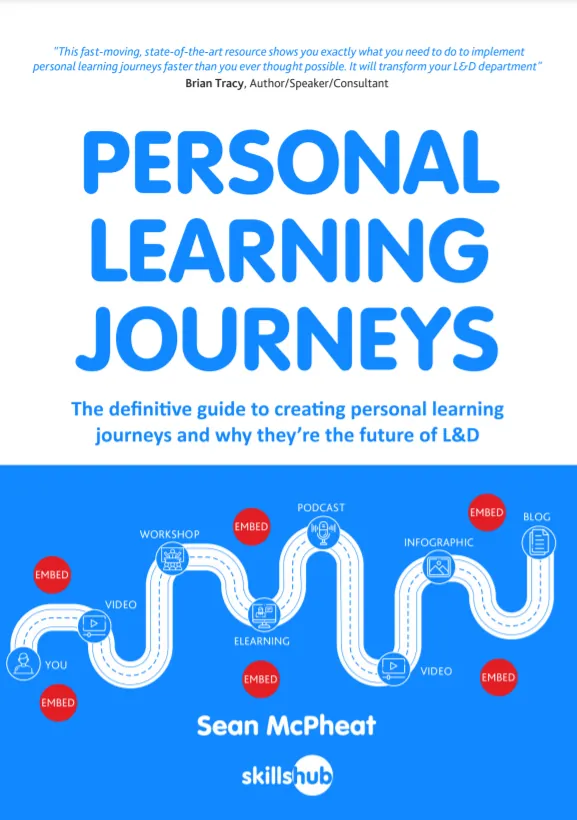The evolution of online learning as a practice has seen a fast-forward in recent years and the development of online learning platforms is no different.
Advancements in this area have been rapid meaning there is an increased demand and onus on businesses to adapt their training processes and offer employees an online learning platform that is intuitive, engaging and enjoyable to use if you are to see a return on investment.
This article takes a look into the world of some of the best online learning platforms and some of the must-have features that you need to look for when sourcing a platform.
Should You Use an Online Learning Platform or LXP?
We call it an online learning platform. Others call it a learning management system or LMS system or an LXP which stands for learning experience platform.
Whichever term you use to refer an online learning platform, it should be able to fulfil a certain amount of basic functionality.
There are eLearning providers out there who offersystems with a range of bells and whistles that you simply won’t use.
For example, your learners may have the option to engage in social learning where they can record themselves on a phone and then upload it to your system. Learners can discuss topics and rate them with thumbs up and thumbs down. There are a whole other host of features that come under the social learning feature.
It may sound like a really cool feature, however in practice, it can be difficult to police and quality control all of the learner generated content that they will produce It is therefore important to choose a solution that is right for your requirements and goals today, that you can grow into tomorrow.
We come across so many organisations in the UK and worldwide that select an online learning platform that offers tons of features and options, only for it to completely overwhelm them when deploying it throughout the company.
Our advice would be to start small and make incremental changes as you go.
Best Online Learning Platform Features
With such a wide range of online learning platforms out there, it can be difficult for organisations to decide which is going to be the right one for them.
What look and feel should it have? What do you need it to do in order to support both your learners and L&D effectively? Is the solution just for your own learning resources, or are you looking to include content from others as well?
Given that most providers will tie you into a contract for 12 months or longer, it’s important that you make the best choice for your learners and your organisation – to avoid getting locked into a deal that doesn’t work for you in the long term.
There are so many bells and whistles to choose from.
Here we focus on the ten must-haves of any online learning platform to help you cut through the technical jargon and make the right decision for you.
1. User-friendly and intuitive learner interface
All the features provided by an online learning platform should flow and be designed with the learner’s experience in mind. Your learners should be able to log on quickly through one-step sign-ins, easily navigate themselves around the site, find relevant learning resources within just a few clicks and be engaged throughout the process.
When considering which learning platform is best for you, ask to take a trial or free demo as a completely new user and see how quickly and easily you can find and access what you need – without their sales or tech team providing you with step-by-step instructions.
Some will even have Getting Started sections and How To tutorials, which will be a great asset in getting your learners up to speed with how to use the platform – without needing additional input from L&D.
Remember, if it’s not easy to use, it will not be used. No matter what it offers, if your learners can’t find relevant online courses and content then forget about it.
The whole learner experience has to be slick, easy and personalised.
2. Responsive design
Not all learning is conducted during working hours and on a desktop, so a responsive design is a must in order to enable learners to log on at any time, from any device.
This goes for the learning resources as well. Ensure that you test out the responsiveness of the solution that you select and any preloaded content within it before you make your decision.
I have seen learning management systems which provide a great learning experience only for their content to shift on the page, not open correctly on mobile or be so small that it’s not worth attempting to work through the session.
3. Variety in learning resources
Having an LMS platform which only provides access to one or two types of online training and learning resources is going to limit the engagement with learners – and is going to send you back to the days of clunky and ineffective training management systems.
Your online learning platform should enable you to upload and have access to word documents, PDFs, images, audio files, video files, online courses and face-to-face courses as a bare minimum.
People learn in different ways so ensure you cater for that.
4. SCORM and or xAPI compliant
Most learning content is either SCORM (Sharable Content Object Reference Model) or xAPI (experience API) compliant, different protocols with the same aim, which ensure that it meets the industry technical standards for online learning content.
There are currently five versions of SCORM, so it’s vital that your learning platform is compatible with at least one of these to ensure that you can access a wide variety of learning materials both now and in the future.
5. Automated learning journeys
As a learner, a line manager or an L&D professional, your online learning platform should support you in creating personalised and structured learning journeys that can be scheduled and distributed automatically.
Not having the ability to create, schedule and automate access to learning resources and training content is just like providing learners access to an online content library and hoping they will consume the content. A bit like surfing around Netflix or Amazon Prime.
It’s important that your learners and your administrators can send and receive “push notifications”, to help keep them on track and engaged throughout the learning process.
6. Easy and effective administration and reporting
A major benefit of purchasing an online learning platform is that you can quickly, easily and effectively upload users and content to the system, manage roles and access levels and report back on how people are using the system and what they are doing with the learning.
Ensure that you have several members of your L&D function test the admin profile and settings before making a decision asyou don’t want to get tied into a contract only to find that you’re spending hours adding learners, struggling to manage them once on the system and finding yourself unable to access the reporting you need.

Learn How To Create Personal Learning Journeys For FREE!
7. Avoid authoring tools
Whilst this list is compiled of positive “must haves”, it is not essential to have an authoring tool within your system.
Built-in authoring tools normally consist of a basic editor which creates a slide deck that you add basic features like a voiceover or quiz.
Online learning platforms have moved on since then, and instead, werecommend that you use a variety of external tools to help you create different types of online courses and digital learning resources.
Whilst a number of organisations will have their own content developers, others will rely on their key L&D personnel to create new learning material for their employees. If this is you then you can look at authoring tools like Articulate Storyline, Rise and Adobe Captivate. These will enable you to create simple and effective online learning sessions, assessments and quizzes. The alternative and easier option is to lease off-the-shelf eLearning content.
8. Collaboration and social learning tools
To maximise the effectiveness of any solution, you need to be offering more than just L&D-defined content and courses.
Whilst there will likely be mandatory learning that you will want people to engage with, many organisations are now also seeing the benefits of collaborative and social learning that are driven by their own employees.
As we mentioned earlier, however, your platform needs to be right for your organisation. You’ll want to select a training platform that has the ability to turn on social learning when you are ready to manage this.
Social learning encourages the sharing of best practices and peer discussions through content that your employees create and participate in – without the need for L&D to spearhead or drive.
Having access to collaboration tools such as live video diaries, group discussions and forums and personal blogs – will ensure that your organisation is set up to move towards the future of learning and better support your people and their preferences.
Imagine that an employee has just had a client meeting and they used a killer phrase which won the deal, it would be worth sharing.
Or, someone has found a hack to reduce the time it takes to do a task – you’ll want to share that with everyone using the learning platform.
9. Integrated and fully documented API
You may have other software to integrate with, such as your CRM or talent management/HR database, so it’s important that your online learning platform can “talk to” existing systems in order to save on additional time and resource transferring data from one to another.
Whilst it’s rare that any online learning platform will already integrate with all of your existing systems when you purchase it, ensuring that it has a fully documented application program interface (API) will mean that you can effectively integrate this with whatever systems you need in the fullness of time.
The key aspect of API is that it is fully documented, so you are not reliant on the provider to set this up for you at a potentially hefty cost. If you have developers internally they can do this for you at no additional charge.
10. Scalability
It’s important to ascertain that an online learning platform can be scaled up in terms of the number of users and its functionality, so ask about their development roadmap to understand more about how the platform might be able to support you in the future.
You want to partner with a provider who can grow with you, so ask the question upfront, before making your final decision.
It’s vital that as your organisation grows and your learners develop, you are able to support their current and future needs – so cutting through the “noise” and focusing on these top ten must-haves will help guide you in making the best decision for your online learning platform.

How to Choose an Online Learning Platform
There are hundreds of vendors to choose from in this marketplace that it can feel overwhelming.
You’ll need to create a shortlist and hold internal discussions with all the key stakeholders at your company to nail down which vendor you are going to put your trust in.
As a vendor ourselves we can tell you that a lot of organisations approach Skillshub without having put the time and effort into crystalising their own thoughts as to what they want the system to do in the first place.
What results is confusion as many vendors discuss and present their propositions. What normally happens when there is confusion is that no decision is made.
Before you approach an online learning platform provider, it’s important to line up your own ducks and establish exactly what your needs are.
Here are some tips on how to identify your requirements for an online learning platform:
1. Know your why
Why do you need a learning platformIs it because everyone is moving to a digital solution? It’s very important to understand why you want to go down this route. Are you looking to provide learning at scale? Moving towards a blended learning solution? To cut costs associated with face-to-face travel? To improve knowledge retention rates because of shorter learning sessions? You need to be clear as to your why.
2. Conduct a training needs analysis
Armed with your why, is there sufficient demand for a platform now and in the future? Conduct a training needs analysis, and talk to staff and the managers within yourbusiness to gain an understanding of what learning is required. Where are the gaps between where you are now and where you want to be? By doing this you will gain valuable insight into potential online training content that you may need as well as some of the key features that your system will need to be able to carry out. Review your current provision, programmes and internal learning processes to see where the gaps are.
3. Create a list of “must have” and “nice to have” features
It’s important to create two lists because you will receive an avalanche of features and benefits from each vendor and you will need to be able to categorise those elements into what you must have and those features that would be nice to have. Remember that some features may not be important to you now, but they might be in 18 months so it’s important to think long term.
4. What don’t you want?
As an extension to the point above, it’s a valuable exercise to create a list of those features and capabilities that you don’t want or need an online learning platform to offer. For example, if your company culture and ways of working will not be suitable for social learning, make a note not to seek that in a platform. Some LMS’s are built around certain aspects like social learning, so you don’t want to waste your time trialling them. Create a thorough“don’t want” list of platformn features.
5. Approach and evaluatesuppliers
You will no doubt trawl through the internet to draw up your shortlist of those suppliers to approach. Check out what their sites look like and the capabilities of their platforms against your three lists of:
• ‘Must have’ features
• ‘Don’t want’ features
• ‘Nice to have’ features
Draw up a shortlist of those that you are going to approach and create a short requirements document to send them. When approaching different providers, it is useful to send them the whole story of your business’ objectives rather than just a list of requirements. It’s useful for each vendor to gain some context behind the decisions.
6. It’s showtime!
The best way to evaluate an LMS is to have a demo of it. It’s important to have potential users on that demo as well. The more feedback you can get from them the better. It’s a big decision so always ask what onboarding support the provider will offer as well. Do they just take your money and run? Or will they hold your hand and become an extension of your business whilst you are integrating into your current and future learning and development plans.
The Future of Online Learning Platforms
Systems are sure to continueevolving in the future. Some are now already using artificial intelligence to predict what learners need based on their usage habits, assessment scores and regular diagnostics that they might take.
It can be important not to simply go for the online learning platform that offers the most features asyou’ll most likely pay higher costs and only utilise a small number. Instead, sit down with your L&D colleagues and the business and work out exactly what it is you are trying to achieve.
Move away from training consumption targets like how many sessions someone has worked through or how long they are spending on the online learningplatform each month.
Instead, start to measure what they are doing with the learning and what the business benefits are. Are they closing more deals? Is staff attrition falling? Are they more productive?
When it comes down to it, the motto of “if you build it,they will come” does not work when it comes to online learning platforms. You can offer your learners hundreds of features on a platform, but it’s like having a £400,000 Lamborghini andnot knowing how to drive it.
Choosing the right online learning platform is about finding a system that has tangible benefits for your business in terms of return on investment, but also one that provides your team with an enjoyable, streamlined learning experience.
If you’re ready to level up your L&D strategy with the help of an eLearning company, check us out here at Skillshub if you are looking for eLearning content.














